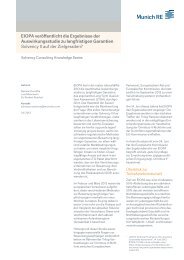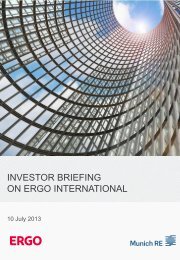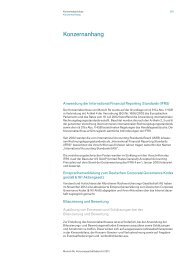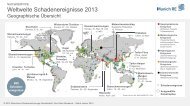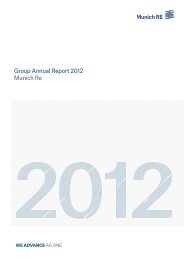Munich Re Group Annual Report 2006 (PDF, 1.8
Munich Re Group Annual Report 2006 (PDF, 1.8
Munich Re Group Annual Report 2006 (PDF, 1.8
Create successful ePaper yourself
Turn your PDF publications into a flip-book with our unique Google optimized e-Paper software.
<strong>Munich</strong> <strong>Re</strong> <strong>Group</strong> <strong>Annual</strong> <strong>Re</strong>port <strong>2006</strong><br />
Economic growth in Japan was 2.2% in real terms last year –<br />
slightly higher than in 2005.<br />
The economy in the eurozone performed significantly<br />
better in <strong>2006</strong> than in the previous year. In particular,<br />
domestic demand (investments and consumption) gave<br />
rise to real growth, which totalled 2.7% for the year as a<br />
whole. There were marked regional differences: economic<br />
growth in Ireland and Finland, for example, was well above<br />
average, whereas in Italy and Portugal it remained comparatively<br />
subdued.<br />
The German economy grew by 2.7% in real terms in<br />
<strong>2006</strong> – a considerable improvement on the previous year.<br />
The pleasing aspect of this development was that growth<br />
derived not only from exports and corporate investments<br />
but also from private consumption, which also made a<br />
more positive contribution again for the year as a whole<br />
(buoyed by the resurging labour market). An initial estimate<br />
indicates an annual average rise of approximately<br />
176,000 in the number of employees with jobs subject to<br />
social insurance, whilst the unemployment rate stood at<br />
9.6% in December, a year-on-year decrease of 1.5 percentage<br />
points.<br />
Economic development in the UK was also up appreciably<br />
year-on-year, driven mainly by domestic demand.<br />
In <strong>2006</strong>, growth in the emerging markets accelerated.<br />
China expanded strongly again with 10.7% in real terms.<br />
The Indian economy also continued to develop at a high<br />
level.<br />
Among the central and eastern European countries,<br />
Russia and Poland added to the momentum, whereas in<br />
Turkey the expansion slowed somewhat, due not least to<br />
a strong depreciation of the currency in May and June.<br />
In Latin America, Brazil and Mexico in particular<br />
ensured that the region grew more strongly than the<br />
previous year.<br />
Due to falling oil prices since August, rates of inflation<br />
around the world dropped especially in the final quarter –<br />
in some cases considerably. However, the annual average<br />
inflation rate remained at around last year’s level in the<br />
USA and the eurozone. This environment led to further<br />
interest-rate increases by a number of central banks. The<br />
US Federal <strong>Re</strong>serve raised its reference interest rate from<br />
4.25% at the start of the year to 5.25% at the end of June,<br />
but then left it unchanged up to the end of the year. The<br />
European Central Bank increased its reference interest rate<br />
from 2.25% to 3.5% during the course of the year, and the<br />
Bank of England raised its key interest rate from 4.5% to<br />
5.0%.<br />
62<br />
Management report_Parameters<br />
Capital markets<br />
By and large, prices on the international stock markets<br />
moved upwards in <strong>2006</strong>: the EURO STOXX 50, for instance,<br />
improved by 15.1% and the DAX by 22.0%.<br />
In the USA, the S&P 500 also recorded presentable<br />
growth of 13.6%. The Japanese Nikkei Index, however,<br />
recorded an increase of only 6.9%.<br />
Starting from a level of 3.3% at the beginning of the<br />
year, yields on ten-year German government bonds initially<br />
rose to around 4.1% by July against the background<br />
of positive economic expectations and comparatively high<br />
inflation. In view of declining rates of inflation and a cooling<br />
of the US economy, however, yields subsequently fell<br />
to almost 3.6% at the beginning of December, before<br />
renewed economic optimism caused them to rise again to<br />
nearly 4.0% at the end of the year. Having started the year<br />
at just under 4.4%, yields on ten-year US government<br />
bonds climbed to a good 5.2% by the end of June, only to<br />
recede to about 4.7% at year-end.<br />
The euro gained considerable ground against the<br />
US dollar in the course of the year, its price rising from<br />
US$ 1.18 to US$ 1.32. It also climbed against the Japanese<br />
yen, moving up from ¥139.22 at the start of the year to<br />
¥157.12 at the end of <strong>2006</strong>.



